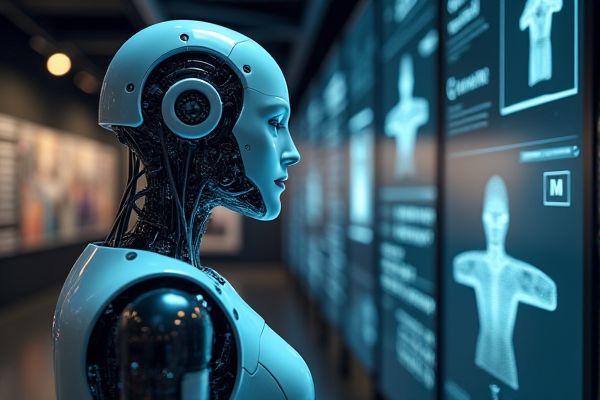
AI technologies enhance museum management through improved visitor engagement and operational efficiency. Intelligent data analysis helps curators understand visitor preferences and behaviors, allowing for personalized experiences and tailored exhibitions. Predictive analytics can optimize resource allocation, streamline inventory management, and assist with financial forecasting. Automation of routine tasks, such as ticketing and visitor guidance, frees staff to focus on enriching the educational experience for patrons.
AI usage in museum management
Visitor Analytics
AI can significantly enhance visitor analytics in museum management by processing large datasets to identify patterns in visitor behavior. For example, by analyzing ticket sales and entry times, museums can optimize staffing and improve exhibit placement to increase engagement. The possibility of personalizing visitor experiences through tailored recommendations could lead to higher satisfaction rates. With advancements in AI technology, there's a chance for museums to create data-driven strategies for marketing and event planning, ultimately boosting overall attendance.
Interactive Exhibits
AI can enhance museum management by streamlining operations and improving visitor engagement. For instance, interactive exhibits powered by AI can adapt to individual preferences, making the experience more personalized. This technology can also analyze visitor data to optimize exhibit layouts and themes, increasing overall satisfaction. Implementing AI in institutions like the Louvre could potentially attract more visitors and enhance educational outreach.
Collection Digitization
AI can enhance museum management through efficient collection digitization processes. By leveraging machine learning algorithms, museums can categorize and tag artifacts, making them more accessible to the public. Digital tools such as virtual tours or augmented reality can create engaging experiences for visitors, increasing attendance and interest. Institutions like the British Museum are already using technology to expand their reach and improve visitor engagement, demonstrating the potential advantages of AI integration.
Personalized Visitor Experience
AI can enhance museum management by providing personalized visitor experiences tailored to individual preferences. For example, an art museum might use AI algorithms to recommend specific exhibits based on a visitor's prior interests. This can increase visitor engagement and satisfaction, leading to higher attendance and revenue. The potential for deeper connections with art and history makes AI a valuable tool in the cultural sector.
Virtual Reality Tours
AI usage in museum management can enhance visitor experiences by providing personalized recommendations based on interests. Virtual Reality Tours offer an immersive way for users to explore exhibits from anywhere, potentially increasing engagement. Tools like predictive analytics can help museums optimize exhibit scheduling and resource allocation. These advancements may lead to higher visitor numbers and improved educational outcomes for institutions like the Smithsonian.
Art Restoration
AI can enhance museum management by streamlining inventory processes and improving visitor engagement through personalized experiences. In art restoration, AI algorithms can analyze paintings to identify areas in need of repair, estimating the best methods for restoration procedures. Institutions like the Metropolitan Museum of Art are exploring these technologies to optimize their operations and preserve artworks effectively. The potential for AI to enhance efficiency and accuracy presents a significant advantage in the cultural sector.
Inventory Management
AI can enhance museum management by optimizing inventory tracking and organization. For example, it can automate the cataloging of artifacts, reducing manual labor and minimizing errors. Museums can leverage AI to analyze visitor trends and preferences, potentially increasing engagement and attendance. This technology allows for more informed decision-making regarding exhibitions and resource allocation.
Multilingual Support
AI can enhance museum management by providing multilingual support to cater to diverse visitor populations. For example, a prominent institution like the Louvre could use AI-driven chatbots to translate exhibits and provide real-time information in multiple languages. This capability increases accessibility, allowing more visitors to engage with the artwork and historical pieces. Implementing AI in this way presents an opportunity for museums to improve visitor experience and expand their audience reach.
Predictive Maintenance
AI usage in museum management can enhance predictive maintenance efforts by analyzing data from museum artifacts and exhibit equipment. For example, an institution like the Louvre can implement AI algorithms to forecast when environmental controls or display mechanisms may need servicing. This proactive approach may reduce downtime and preserve the integrity of valuable collections. Moreover, efficient maintenance schedules can optimize resource allocation and potentially lower operational costs.
Accessibility Enhancements
AI can improve museum management by providing personalized visitor experiences and optimizing operational efficiency. For example, museums like the British Museum have utilized AI to enhance accessibility for individuals with disabilities, making exhibits more engaging and inclusive. Implementing AI-driven tools can enable better crowd management and exhibit curation by analyzing visitor data. The potential for AI to streamline processes may result in increased visitor satisfaction and enhanced educational opportunities.
 techknowy.com
techknowy.com